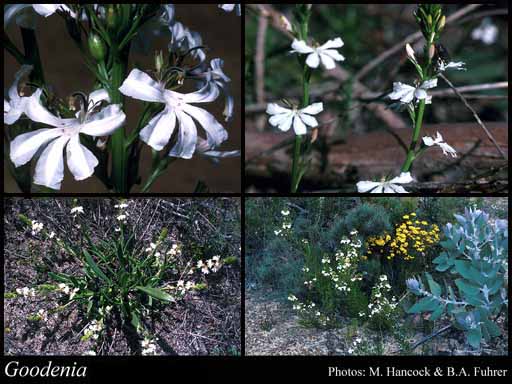- Reference
- Spec.Bot.New Holland 15 (1793)
- Name Status
- Current

Scientific Description
Common name. Goodenias. Family Goodeniaceae.
Habit and leaf form. Shrubs, or herbs. Annual, or perennial. Leaves basal, or cauline, or basal and cauline. Plants with a basal concentration of leaves, or with neither basal nor terminal concentrations of leaves. Stem internodes solid (ass.). Mesophytic, or xerophytic. Leaves alternate; spiral; petiolate to sessile; non-sheathing; simple; epulvinate. Leaf blades dissected (occasionally), or entire; flat, or folded, or solid; sometimes terete, or semi-terete; linear, or ovate, or obovate, or oblong, or elliptic; when dissected, pinnatifid; pinnately veined. Leaves without stipules. Leaf blade margins entire, or serrate, or dentate. Leaves without a persistent basal meristem. Leaf anatomy. Hairs present, or absent; glandular hairs absent, or present; complex hairs present, or absent. Extra-floral nectaries absent (ass.). Stem anatomy. Secondary thickening absent, or developing from a conventional cambial ring.
Reproductive type, pollination. Fertile flowers hermaphrodite. Unisexual flowers absent. Plants hermaphrodite. Entomophilous. Pollination mechanism conspicuously specialized (involving a stylar modification for pollen presentation).
Inflorescence and flower features. Flowers solitary, or aggregated in ‘inflorescences’; terminal, or axillary; in cymes (in a thyrse), or in racemes, or in spikes, or in umbels (or subumbel), or in panicles, or in fascicles (or clusters). The terminal inflorescence unit cymose, or racemose. Inflorescences scapiflorous, or not scapiflorous; terminal, or axillary; with involucral bracts (rarely), or without involucral bracts. Flowers pedicellate (usually), or subsessile to sessile; ebracteate (ass.); bracteolate, or ebracteolate; small to medium-sized; very irregular. The floral asymmetry involving the perianth and involving the androecium. Flowers 5 merous; cyclic; tetracyclic. Free hypanthium absent. Perianth with distinct calyx and corolla; (8–)10; 2 -whorled; isomerous, or anisomerous. Calyx present; 5; 1 -whorled; gamosepalous; tubular. Corolla present; 5; 1 -whorled; appendiculate (the upper lobes sometimes auriculate), or not appendiculate; gamopetalous; lobed. Corolla tube adaxially deeply split. Corolla valvate; bilabiate; hairy abaxially, or glabrous abaxially; hairy adaxially; white, or cream, or yellow, or red (brownish), or pink, or purple, or blue; spurred, or not spurred. Androecial members definite in number. Androecium 5. Androecial members free of the perianth, or adnate; all equal (ass.); free of one another; 1 -whorled. Androecium exclusively of fertile stamens. Stamens 5. Staminal insertion near the base of the corolla tube. Stamens all inserted at the same level; all more or less similar in shape (ass.); isomerous with the perianth; oppositisepalous (at the base of the corolla); all alternating with the corolla members. Anthers separate from one another; basifixed; dehiscing via longitudinal slits; introrse; tetrasporangiate. Pollen shed in aggregates, or shed as single grains. Gynoecium 2 carpelled. The pistil 1–2 celled. Gynoecium syncarpous; synstylovarious to eu-syncarpous; partly inferior (summit of ovary extends upwards within the corolla tube), or inferior (AKPB). Ovary plurilocular; 2 locular (usually incompletely). Gynoecium stylate. Styles 1; bearing an ‘indusium’ beneath the stigma. Indusium cupular. Styles apical. Stigmas 1–4. Placentation axile. Ovules 20–50 per locule (numerous to few, rarely solitary per locule); ascending; non-arillate; anatropous.
Fruit and seed features. Fruit non-fleshy; dehiscent; a capsule. Capsules valvular. Fruit 2 celled (usually, or 4); 1 seeded (to more than 2 per locule). Seeds copiously endospermic. Endosperm oily. Seeds compressed; usually winged. Cotyledons 2. Embryo straight.
Special features. The upper lip of the corolla incorporating 2 members, the lower 3; (posterior, adaxial) lip of the corolla bilobed. Lower (abaxial) lip of the corolla 3 lobed.
Etymology. After Samuel Goodenough (1743–1827), Bishop of Carlisle, first treasurer of the Linnean Society. He deplored ‘the gross prurience of Linnaeus' mind’ as shown in his sexual system of plant classification.